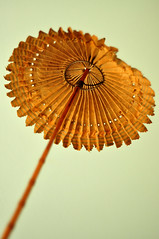My latest antiques buy was an eBay find, it was so unusual I had to bid on it, unsure if it was a parasol, as the seller thought, or if it was a hand held fire screen, similar to some ivory-handled examples I had seen about a year ago.
When it arrived, though, it became pretty clear that a fire-screen this was not. It's a parasol for sure. But it was very much unlike any other example I had seen.
Plus, it had a patent date on it. And that got me started on my research.
Innovation was a Victorian specialty. Nineteeenth century philanthropists, home-spun and ivy-league educated, believed it could bring about social reform. Those whose aspirations were less high-minded pursued innovation to seek fortune, or to make life more convenient.
The inventor as a hero reached its peak during the nineteenth century. While it was Alexander Graham Bell and Thomas Edison who have become today’s household names of nineteenth century innovators, the everyday man was getting into the act as well.
The result of this is hundreds of thousands, if not millions of patents for every kind of object, apparatus and gadget. Most of these patents were placed in archives, and today are searchable online. This made things really easy for me.
The patent date on the turned, lightly colored wooden handle, was December 24th, 1867. A couple internet inquiries matched this date to a patent issued to a Cornelius St. John of Charlestown, Massachusetts.
Cornelius St. John has a number of patents on file. Not including the patent that he was issued for the design of this parasol, he was issued a patent for a lamp (Pat. No. 72242, Nov. 19th, 1867), a lamp burner (Pat. No. 75483, March 10th, 1868), and most unusually a device for self-teaching of the Harmonica (Pat No. 176124, 1876). By 1876, St. John had moved from Charlestown and had settled in Boston.
St. John appears to have been involved in some part with oil lamps during the late 1860s, as both patents for the lamp and lamp burner of 1867 and 1868 respectively indicate, as does his patent for the Improvement in Parasols (Pat. No. 72695) which indicates that the design of the folded canopy of the parasol is not unlike the paper lamp shades of a lamp. I’ve not yet been able to conclusively say what exactly St. John’s profession was at the end of the 1860s.
As the patent shows, the diminutive sunshade is opened by a metal ring which slides up and spreads the pleated canopy. This same ring holds the canopy closed when not in use. The canopy is a polished cotton material. I was surprised to find that the canopy was lined also with polished cotton. The outside is a brown and steel-blue, but looking in between the tight pleats toward the top of the canopy indicates that these stripes were originally azuline blue, of the extremely vivid, aniline dye variety.
So, it’s kind of neat. And in an odd coincidence, I was packing up the packing material leftover after I had unwrapped it, and noticed the return address. It came from Cold Spring, New York, where I spent a week in December of 2008 with a photographer friend of mine, and it came from the antique shop that my friend Jen and I went into one of the days on my visit, owned by an antique dealer who Jen took this portrait of. It put a smile on my face. I’m happy I helped support Cold Spring’s economy. Because I like Cold Spring.

No comments:
Post a Comment